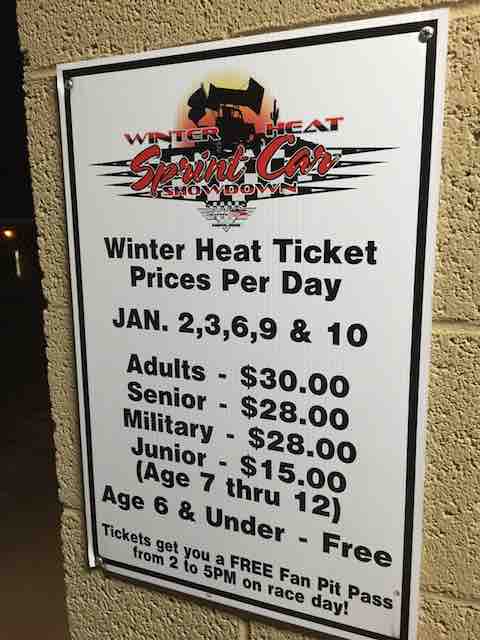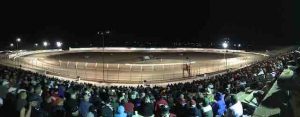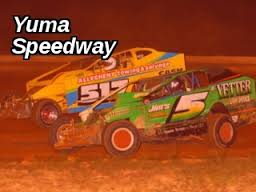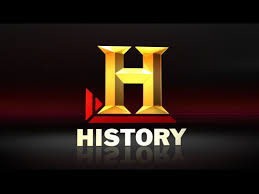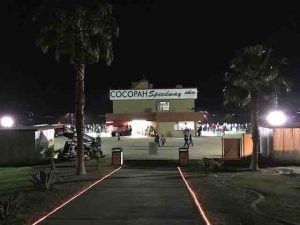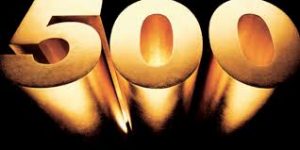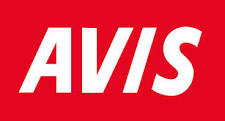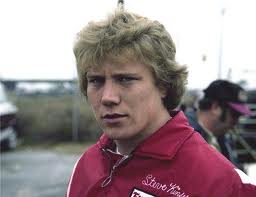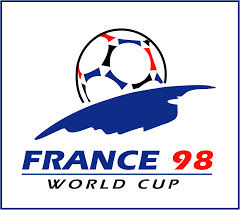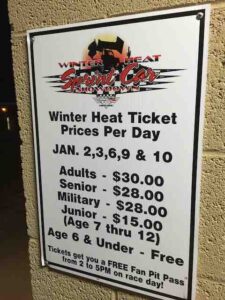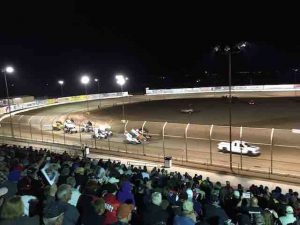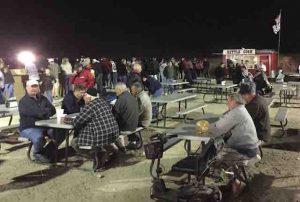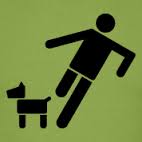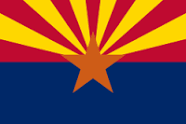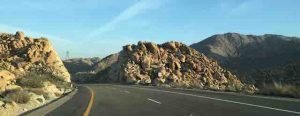Greetings from Somerton, Arizona
From the travels and adventures of the
“World’s #1 Trackchaser”
Yuma Speedway Park (now known as Cocopah Speedway) – Lifetime Track #326
Editor’s note: I first went to the “Yuma Speedway Park” on April 18, 1998. This track was my 326th lifetime track to visit. As I didn’t begin writing my famous Trackchaser Reports until about track #430 I have almost no formal notes from this track visit.
I do know that track #325 was the Batesville Speedway in Batesville, Arkansas. Track #327 was the Hartford Speedway in Hartford, South Dakota. Yes, even 16 years ago I was doing a lot of trackchasing travel.
There was something very special about visiting the old Yuma Speedway Park back in ’98. Son J.J. flew us to the races in a private plane! I’ve only done that a time or two! We “Weber-cooked” popcorn during our stay.
That old track has now been replaced, in the same location, with a brand new pristine dirt track facility. It’s called the “Cocopah Speedway”. I made a return visit to see what kinds of changes had been made since my last visit 16 years ago. There were a LOT of changes. I didn’t ever recognize the place although that is not all that unusual when returning to tracks I’ve seen well over 1,000 tracks ago.
Here’s a nice summary of the history to today’s track since its inception in 1968. I found the information at www.cocopahspeedway.com.
Speedway History
Golden had the vision; Thomas had the means; Cocopah Tribe has the reins
43 years later, ideal location now has the ideal race track
By Randy Hoeft
“To me, Yuma is the ideal place in the world for a race track,” said Frank Golden. And with that thought in mind, he picked out what he felt was the ideal location, and built Yuma Speedway. That was 43 years ago.
The original Yuma Speedway, a bull-ring of a quarter-mile oval, opened its doors for the first time on March 24, 1968. It was a sunny Sunday afternoon and a crowd estimated at 2,500 turned out to watch Yuma’s Orvis Fugate start dead last in a 16-car, 20-lap feature race and win it all. Second place that day went to Brawley’s Bill Pistole and third place to another Yuma driver, Phil Moravec. Jimmy Love won the trophy dash and got a kiss from the trophy queen, Charlotte Peach.
Fast forward to today. Although the name has been changed to Cocopah Speedway, the location is still the same and the breathtaking view of the Yuma Valley from the grandstand is still, well, breathtaking.
But make no mistake about it, this is not the Yuma Speedway that was built by Frank Golden in 1968. It may be the Yuma Speedway that Golden envisioned, but any similarity between the present-day facility and the original are purely coincidental.
Golden came to Yuma from Oklahoma in 1933 and worked the produce industry. As a youth growing up in Pauls Valley, Okla., he said he would collect Coke bottles to earn his admission into the local race track. And when he got to Yuma, he was one of the drivers to try their luck at the California Arizona Racing Association track in Winterhaven in 1965. “That experience,” said Dick Rautenberg, who raced against Golden on the Winterhaven track 46 years ago, “is what inspired Frank Golden to build Yuma Speedway. “When (the Winterhaven) track closed, Frank decided to build his own track,” said Rautenberg.
At the conclusion of that first season at Yuma Speedway in 1968, Golden and the Yuma Speedway Stock Car Racing Association hosted an awards dinner at the Yuma Jaycees Clubhouse. There, Yuma’s Dan Westbrook received one of the four Rollover Trophies; the late Rocky Jones, also from Yuma, was named Rookie of the Year; and Rautenberg was crowned the track’s first driving champion. Rautenberg also received the Sportsmanship Trophy.
For the next 10 years Golden, with his wife Flo at his side, operated the track, dealing with one obstacle after another, never seeing the facility live up to his expectations. Finally, in late September 1978, Golden, suffering from failing health, announced he was selling the track to a California man. In an interview in The Yuma Daily Sun, Golden said, “If I were 20 years younger, I’d never have sold it.
“If I were 20 years younger, I’d build a three-eighths track, bring in six to eight events a year – using Late Model cars – and institute motorcycle racing.” Golden died in April 1981, having not seen a race car on his track since the 1978 season finale. A disagreement over operation of the track between Golden and a fledgling group of drivers, who called themselves the Yuma County Automobile Racing Association, led to the drivers opening their own track. Ironically, it was the same track in Winterhaven where Golden had driven in 1965, where he had been inspired to build Yuma Speedway. The drivers operated their track in Winterhaven until 1988 when word got out that a Yuma heavy construction contractor, Jerry Thomas, was purchasing Yuma Speedway, and had grand plans for the racing facility. Thomas actually became the fourth owner of the track when the deal was finalized. He had been preceded by two others who had tried – and failed – to entice big-time racing back to the Yuma Valley. And by the time Thomas came onto the scene, Yuma Speedway had been reduced to nothing more than a run-down, dilapidated, dust bowl of a racing facility. But the rumors about Thomas were true. He spent nearly $1 million in renovations and created one of the most talked about, three-eighths-mile dirt tracks this side of the Mississippi River. For his efforts, Thomas received a national promoters award for his creation, or rather his re-creation.
“It’s turned out a lot better than I thought, but that’s only because it was worse than I thought,” said Thomas on the eve of his track’s re-opening in September 1989. “Things were so bad that we wound up doing more than we expected.”
Thomas was passionate about the track and proceeded full-speed ahead with a list of events that are still talked about today. In his first year, Thomas, acting as the promoter as well as being the owner, brought in USAC Midgets, the World of Outlaws, the California Racing Association non-winged sprint cars and the Snowbird Classic for late model stock cars, along with the regular local show, which included the introduction of IMCA Modifieds to the Yuma area. There were also Sportsman Division cars, Factory Stocks and Mini Stocks. Soon after, however, Thomas turned over operation of the track in 1991 to Steve Brucker and Andy Therkildsen, who were major players in the operation of Cajon Speedway, a paved track in El Cajon, Calif. A year later Therkildsen bought out Brucker and promoted Yuma Speedway on his own, offering much the same program that Thomas did in his first year.
Therkildsen also tried unsuccessfully to entice the Slick 50 Sprint Car World Series to make Yuma Speedway its home for the winter, but lost out to Canyon Speedway.
Following Therkildsen, Yuma’s Kent Rautenberg decided to try race track promoting in 1994 after stepping away from race cars as a driver. Rautenberg experienced some success, but left the position before the season was over.
He was succeeded by another California-grown promoter, Mark Norris, who, like Therkildsen, had a storied racing career at Cajon Speedway. During Norris’ tenure, from 1995 to 1997, he introduced Yuma fans to the Ego Challenge, in which drivers could bring their cars in off the street and try their hand at setting the fast time around the oval. The event proved to be popular.
Thomas then turned operation of the track over to Dome Valley farmer Ronnie Moore in December 1997. Moore operated the track, which he renamed Yuma Speedway Park, for two years, during which he re-intdroduced sprint car racing to the area with the winged, 410 cars of the Sprint Car Owners of Arizona Empire Cup series. Moore then announced in the fall of 1999 that he had purchased the facility from Thomas, and at the season’s end closed it. Moore said he could no longer afford to operate the facility, locked the gates and put it up for sale. In June 2005 the Cocopah Indian Tribe purchased the facility from Moore.
Unfortunately, in the years the track was inactive, it fell victim to the weather and extensive vandalism, including the theft of all of the facility’s copper wiring. Then, in January 2010, the Cocopah Indian Tribe announced it was ready to get into the race track business and unveiled an extensive renovation project. “The goal of the tribe is to revitalize the race track, along with seating and concessions, in order to provide another family-oriented entertainment venue for the community to enjoy,” said a spokesperson for the Cocopah Indian Tribe. “The tribe is hopeful that the renovations will take place in a timely manner.” Eight months and thousands of man hours later, along with a hefty investment by the Cocopah Indian Tribe, the track was ready to re-open in September 2010 as Cocopah Speedway. “I’m excited,” said David White, who began talking with a tribal spokesperson early in 2009 about the possibility of re-opening the facility. “I’m looking forward to it. I’m excited to see how it progresses after we get things going.”
White, from Yuma, who is a stock car racer himself and cut his racing teeth at this same track, was the primary individual behind Cocopah Speedway’s re-opening, overseeing the refurbishing of the facility. He served as interim racing director.
“I think we are pretty much back to where we were the last time we raced here,” said White prior to the 2010 re-opening. “It’s been along haul, and it’s not just me that’s made this happen. It’s taken a lot of work and a real commitment from the tribe and several volunteers and businesses to make this happen.” Today, the track is beginning a new chapter in its colorful and storied history, starting with the introduction of a full-time director of racing operations, Greg Burgess, from Washington. In the months since Burgess came on board, improvements to the facility have been an ongoing theme, with one of the largest being the removal of the steel retaining fence around the racing surface, and the construction of a concrete wall in its place.
No stranger to racing and familiar with some of the best facilities in the country, Burgess said he would rank Cocopah Speedway with the top five dirt tracks. “This is every bit on scale or can be with Lucas Oil Speedway in Wheatland, Mo., supposedly the best there is and absolutely beautiful; Dodge City Raceway Park, in Dodge City, Kan., also a beautiful facility; Grays Harbor Raceway, in Elma, Wash., which has been said over and over that it is in the top five in the nation; and Knoxville, Iowa. I believe this track can compare with all of those,” said Burgess.
“I was told the foundation is here to do some amazing things, and I’m certainly going to do everything I can to make those things happen.”
THE EVENT
I had no intention of racechasing near Yuma, Arizona when the day began.
I woke up this morning at home in San Clemente, California. I went to sleep back home in San Clemente. In the meantime I put some miles on a rental car. This is how the day turned out.
I didn’t have any plans whatsoever at the beginning of today to head to Yuma, Arizona for a racechasing activity. However, Pennsylvania-based Mike Leone posted a message about his experience at the Cocopah Speedway earlier in the week. This reminded me the track was having a five-day winter racing series for this rurally located Arizona track.
I was free.
It was Saturday. I didn’t have anything going on for the evening. Tomorrow Carol and I were heading up to Los Angeles for dinner with Kristy and J.J. However, tonight was free.
How far, how much?
I quickly went about doing some research. How far would the drive be down to Yuma and back? The answer was “nearly 500 miles”. I certainly didn’t want to drive my car that far. So I checked out some nearby rental car locations in first Oceanside and then Mission Viejo California.
Who would give me a car?
These were neighborhood the rental car locations. Their hours were very restrictive. They closed early in the afternoon on Saturday and some were not open on Sunday at all. It certainly wasn’t like renting a car in a major airport.
However I did find a local place that would work. I would rent a car from Avis. There I could rent an economy car for just $29. I would likely save about $15 on gasoline compared to what my Lexus SUV would use. That meant I was only paying about $14 to keep from adding 500 miles to the odometer of my own personal car. Normally I would drive my own car about 500 miles in two weeks. I certainly wouldn’t want to put 500 miles on it in 12 hours.
Carol didn’t share the same enthusiasm for this last minute adventure.
I cleared the idea with Carol. She didn’t fancy getting home at 2 a.m. or later so she passed on the “opportunity”. I also had to account for a one hour time change between California and Arizona. During the winter Arizona is part of the Mountain Time Zone. Then during the summer they don’t change their clocks and have the same time as California does. Weird!
I gathered up some warm clothes. The temperature at race time would be in the low to mid 60s. I also grabbed a pair of goggles. Sprint cars can be dust generators. The program would be much more enjoyable if I had my goggles.
Ya gotta keep your eyes open.
On the way to pick up my rental car I had a package to drop off. Our home’s intercom is on the blink. We were returning it for repair. When UPS told me they wanted $42 to ship the item in the least expensive option I was shocked. I took an extra five minutes to stop off at the post office. They were willing to ship my box for just $20. The guy working at the post office said “UPS has all those shiny new trucks and we have 25-year-old beaters”. That was why the post office was cheaper according to him.
The Avis Rental Car location in Mission Viejo was a laid-back operation. The guy wanted to give me an SUV. I told him that wasn’t what I was looking for because of the poor gas mileage I would get. He scrounged around and came up with a Nissan Sentra four-cylinder model. That would work well for driving 500 miles in 12 hours.
This is a pretty drive with rugged scenery.
Off I went driving through San Diego County and the mountains that separate San Diego from El Centro, California. As I entered Interstate 8 I could look over to the right and see Mexico just a mile or two away for much of the trip.
Dear AT&T: I never left the country!
In fact I was so close to Mexico, AT&T my cellphone provider was sending me texts. Those texts were advising me about “international roaming” charges as if I WERE in Mexico!
The traffic was easy. My car didn’t have satellite radio. That was a bummer. Nonetheless I was able to use my iPhone and listen to podcasts all the way out to Yuma and back. Right now I’m into a PBS program called Serial. It’s a continuing story about a murder case that happened in Baltimore. I’m about in the middle of that project which has 10 to 12 episodes, each about 30 to 45 minutes long.
The King won’t stop.
I arrived into Yuma at about 6:30 p.m. Mountain Time. It was dark by then. One of the attractions for tonight’s racing was that Steve Kinser, the best sprint car driver of all time, would be racing tonight. Steve is known as “King of outlaws” in sprint car racing. Very few people would disagree with the statement that he is the best sprint car driver ever.
Nevertheless, Steve is now 60 years old. Age catches up with everyone. Heck, I have to dye my hair gray so I can look a little older just to look to get my senior discounts!
I’m not as good as I once was, but I’m as good once as I ever was!
Steve’s not nearly as good as he used to be. I can relate. I like to say “I’m not as good as I once was, but I’m as good once as I ever was!” Last year Steve announced he would no longer run the World of Outlaws sprint car schedule on a full-time basis. He is a 20 time champion of that group that first started racing in 1979. I just hope as he winds down his career he doesn’t get hurt. Others in a similar position of the twilight of their careers have been hurt or even killed.
Things have changed, a lot, since 1998.
I was last out the Cocopah Speedway in 1998. The place has changed a great deal. I think the facility is owned by a local Indian tribe now. Everything at this track is brand-new. However, as far as I can tell, the track location itself is in the same spot as it was during my first visit 16 years ago. That means that I cannot count it as a new track.
Considering my one way driving distance was more than 240 miles I was cutting a little close on my arrival time. The racing was scheduled to begin at 7 p.m. I pulled into the parking lot about 6:35 p.m.
Yuma is in the middle of the desert. The entire parking lot has a sand surface just like most Florida tracks. When you pull into Yuma you can’t help but notice all of the large RV camping areas. This is snowbird heaven for people from the north including Canada.
Pricey but on time.
Admission tonight was a little on the heavy side. General mission was $30 with seniors coming in for a $28 price. At least they accepted credit cards. I like that option at a track. It allows me to gain some rewards points and also eliminates having to go to my bank’s ATM as often. They started on time too! How many times do you hear me say that?
Tonight was the fifth night of a five night racing program that started about 10 days. There were just 32 cars on hand. They ended up running four heat races. They followed races with four 10-lap qualifiers (second heats?). The main event started 24 cars for 30 laps of racing. The race was paying $12,000 to win.
No passing. Did you hear me? No passing!
Tonight’s feature line-up was based upon “passing points”. I like that. You would think with that set up there would be a lot of passing. Wrong!! There was almost no passing. That was the worst part of the evening by far.
All of the amenities at the track our first class. The lighting is great, the PA system is great, the track was smooth and looked bigger than it’s advertised 3/8-mile distance. Tonight’s announcer was good.
A very large crowd was on hand which pretty much filled up a huge grandstand area. At $30 USD per somebody was making some money tonight. They did announce that the series will be held next year beginning on New Year’s day!
The program was run off smartly. In point of fact there was only one yellow flag all night during the 10 races. It could be argued that that one yellow was for a bad start as much as it was for the announced piece of debris on the backstretch. You won’t go to very many sprint car races and see just one yellow flag during the entire night.
The racing sucked.
However I am sad to announce at the racing was not very good at all. There was virtually no passing. The cars hugged the inner lane and played follow the leader all night. I’m amazed that this type of racing can draw such a large crowd at a relatively high ticket price.
Just like I kicked their dog.
I mentioned the lack of passing to the people sitting on both sides of me. You would have thought I kicked their dog. I don’t think they wanted to hear that rhetoric. One fellow told me how great the racing was last weekend. Maybe so but tonight it was exclusively follow the leader.
The only advantage for me, from an entertainment point of view, was coming back to a track that had a 100% makeover from my last visit so many years ago. In reality it was pretty crazy to drive nearly 500 miles to see this type of racing. I will not be back next year.
As soon as the checkered flag flew on the a main event I hustled it out to the parking lot. This allowed me to beat 97% of the crowd to Interstate 8. I did make a brief stop at McDonald’s for a double cheeseburger and small fries. This quick meal would still keep me below my caloric count for the day.
I was now looking at a 3 1/2 hour drive through the California desert and over the mountains to get back into Southern California. I expected to arrive home by 1 a.m. since I was gaining an hour in time zone differences.
Why?
Why did I go so far for tonight’s race? I didn’t have anything else going on tonight. I was only gone from home for 12 hours. I classified the trip as worthwhile. I’m an easy grader!
Arizona
The Grand Canyon state
I have now seen 36 Arizona located venues. I’ve been to Arizona 27 separate times to trackchase. Additionally, I have recorded five AZ tracks in the “Pre-1980” period and one “Figure 8 retroactive” Arizona addition.
Thanks for reading about my trackchasing,
Randy Lewis
World’s #1 Trackchaser
Peoria Old Timers Racing Club (P.O.R.C.) Hall of Fame Member
Arizona sayings: Any boredom you might have will evaporate in the heat
QUICK FACTS
AIRPLANE
No planes!
RENTAL CAR #1
Mission Viejo, CA – trip begins
Somerton, AZ
Mission Viejo, CA – trip ends – 498 miles
Total air miles – 0 (0 flights)
Total rental car miles – 498 (1 car)
Total miles traveled on this trip – 498 miles*
*Miles do not count toward annual trackchasing miles. This was a racechasing event.
TRACK ADMISSION PRICES:
Cocopah Speedway – $30
Total racetrack admissions for the trip – $30
LIFETIME TRACKCHASER COMPARISONS
The three most important trackchasing comparisons to me are:
Total lifetime tracks seen
Total “trackchasing countries” seen
Lifetime National Geographic Diversity results
Total Lifetime Tracks
There are no trackchasers currently within 450 tracks of my lifetime total. Don’t blame me.
- Randy Lewis, San Clemente, California – 2,054
Total Trackchasing Countries
There are no trackchasers currently within 10 countries of my lifetime total.
- Randy Lewis, San Clemente, California – 70
Current lifetime National Geographic Diversity results
- Randy Lewis, San Clemente, California – 4.88
That’s all folks! Official end of the RLR – Randy Lewis Racing Trackchaser Report
Click on the link below for some beautiful desert scenery and winged sprint car racing from the Cocopah Speedway:
A trip through the desert for a night at the Cocopah Speedway

